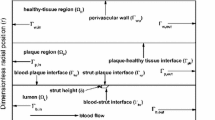Abstract
The safety and efficacy of drug-eluting stents are strongly influenced by the transport of the antiproliferative/anti-inflammatory drugs in the arterial wall. Dissolution in the polymer coating and specific binding in the artery wall play an important role in the process. We consider the model of dissolution, transport and binding of sirolimus on an axisymmetric domain representing the polymer coating layer and the porous artery wall in the vicinity of a stent strut. We employ the FEM on an unstructured mesh to discretize the governing equations. We employ a nonlinear dissolution model for the dynamics in the coating, and a nonlinear saturable binding model that includes both specific and non-specific binding in the arterial wall as separate phases, as proposed by McGinty and Pontrelli (J Math Chem 54:967–976, 2016). The arterial wall is considered an anisotropic porous media, and the flow is considered to be governed by Darcy flow. The permeability in the polymer coating is considered to be very small, but finite. The endothelium lamina, where present, is modelled as a no-flow boundary. The effect of slow and fast release polymers is considered, showing that the time evolution of the process can be efficiently controlled by the polymer diffusion coefficient. In fact, an order of magnitude decrease in the polymer diffusion coefficient results in an order of magnitude increase in the time of drug delivery. It is estimated that 52–54% of the sirolimus mass actually diffuses into the arterial wall. However, the spatial distribution of the sirolimus is greatly influenced by the flow and the arterial wall properties, being therefore susceptible to patient health conditions.















Similar content being viewed by others
References
Bozsak F, Chomaz JM, Barakat AI (2014) Modelling the transport drugs of eluted from stents: physical phenomena driving drug distribution in the arterial wall. Biomech Model Mechanobiol 13:327–347
Changdar S, De S (2016) Analysis of non-linear pulsatile blood flow in artery through a generalized multiple stenosis. Arab J Math 5:51–61
Changdar S, De S (2017) Analytical solution of mathematical model of magnetohydrodynamic blood nanofluid flowing through an inclined multiple stenosed artery. J Nanofluids 6:1198–1205
Changdar S, De S (2017) Transport of spherical nanoparticles suspended in a blood flowing through stenose artery under the influence of Brownian motion. J Nanofluids 6(1):87–96
Changdar S, De S (2018) Analytical investigation of nanoparticle as a drug carrier suspended in a MHD blood flowing through an irregular shape stenosed artery. Iran J Sci Technol Trans Sci. https://doi.org/10.1007/s40995-018-0601-1
Changdar S, De S (2018) Investigation of nanoparticle as a drug carrier suspended in a blood flowing through an inclined multiple stenosed artery. Bionanoscience 8:166–178
Chisari A, Pistritto AM, Piccolo R, La Manna A, Danzi GB (2016) The ultimaster biodegradable-polymer sirolimus-eluting stent: an updated review of clinical evidence. Int J Mol Sci 17(9):1490
Ferreira JA, Goncalves L, Naghipoor J, Oliveira P, Rabczuk T (2017) The influence of atherosclerotic plaques on the pharmacokinetics of a drug eluted from bioabsorbable stents. Math Biosci 283:71–83
Ijaz S, Nadeem S (2017) Biomedical theoretical investigation of blood mediated nanoparticles (Ag–Al\(_2\)O\(_3\)/blood) impact on hemodynamics of overlapped stenotic artery. J Mol Liq 248:809–821
Ijaza S, Iqbal Z, Maraj EN, Nadeem S (2018) Investigation of Cu–CuO/blood mediated transportation in stenosed artery with unique features for theoretical outcomes of hemodynamics. J Mol Liq 254:421–432
Lucena RM (2016) Numerical study of CO\(_2\) dissolution in saline aquifers with deformed interface. PhD thesis, State University of Rio de Janeir
McGinty S, Pontrelli G (2016) On the role of specific drug binding in modelling arterial eluting stents. J Math Chem 54:967–976
McGinty S, Vo TTN, Meere M, McKee S, McCormick C (2015) Some design considerations for polymer-free drug-eluting stents: a mathematical approach. Acta Biomater. 18:213–225
McHugh P, Barakat A, McGinty S (2015) Medical stents: state of the art and future directions. Ann Biomed Eng 1:1–2
McKittrick CM, Kennedy S, Oldroyd KG, McGinty S, McCormick C (2016) Modelling the impact of atherosclerosis on drug release and distribution from coronary stents. Ann Biomed Eng 44(2):477–487
Oliveira GP (2016) Heart diseases and stent technology in Brazil: panoramas, outlooks, challenges. how much interdisciplinary is all that? Private communication, State University of Rio de Janeiro http://www.gesar.uerj.br/media/pdf/seminars/2016/10/peixoto-01.pdf
Polanczyk CA, Ribeiro JP (2009) Coronary artery disease in Brazil contemporary management and future perspectives. Heart 95:11
Teich V, Araujo DV (2011) Estimated cost of acute coronary syndrome in Brazil. Revista Brasileira de Cardiologia 2:85–94
Acknowledgements
The authors would like to acknowledge financial support from FAPERJ, CNPq and the University of Glasgow EPSRC GCF ISF fund.
Author information
Authors and Affiliations
Corresponding author
Additional information
Technical Editor: Cezar Negrao, PhD.
Rights and permissions
About this article
Cite this article
Lucena, R.M., Mangiavacchi, N., Pontes, J. et al. On the transport through polymer layer and porous arterial wall in drug-eluting stents. J Braz. Soc. Mech. Sci. Eng. 40, 572 (2018). https://doi.org/10.1007/s40430-018-1487-8
Received:
Accepted:
Published:
DOI: https://doi.org/10.1007/s40430-018-1487-8




